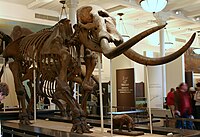
Photo from wikipedia
Over 60% of the modern distribution range of brown bears falls within Russia, yet palaeoecological data from the region remain scarce. Complete modern Russian brown bear mitogenomes are abundant in… Click to show full abstract
Over 60% of the modern distribution range of brown bears falls within Russia, yet palaeoecological data from the region remain scarce. Complete modern Russian brown bear mitogenomes are abundant in the published literature, yet examples of their ancient counterparts are absent. Similarly, there is only limited stable isotopic data of prehistoric brown bears from the region. We used ancient DNA and stable carbon (δ13C) and nitrogen (δ15N) isotopes retrieved from five Pleistocene Yakutian brown bears (one Middle Pleistocene and four Late Pleistocene), to elucidate the evolutionary history and palaeoecology of the species in the region. We were able to reconstruct the complete mitogenome of one of the Late Pleistocene specimens, but we were unable to assign it to any of the previously published brown bear mitogenome clades. A subsequent analysis of published mtDNA control region sequences, which included sequences of extinct clades from other geographic regions, assigned the ancient Yakutian bear to the extinct clade 3c; a clade previously identified from Late Quaternary specimens from Eastern Beringia and Northern Spain. Our analyses of stable isotopes showed relatively high δ15N values in the Pleistocene Yakutian brown bears, suggesting a more carnivorous diet than contemporary brown bears from Eastern Beringia.
Journal Title: Scientific Reports
Year Published: 2019
Link to full text (if available)
Share on Social Media: Sign Up to like & get
recommendations!